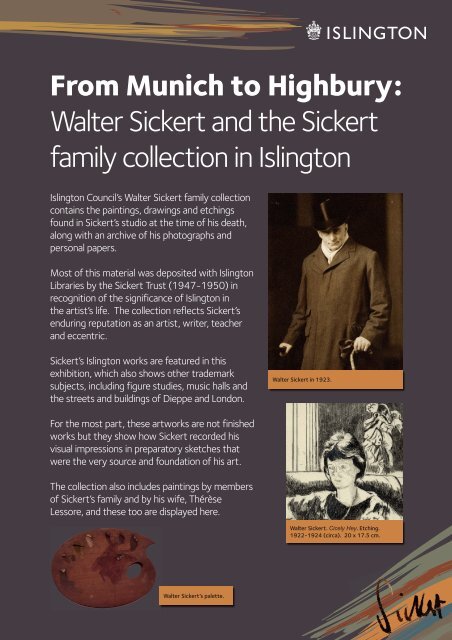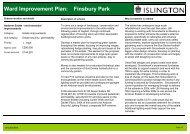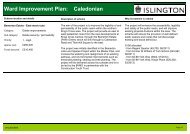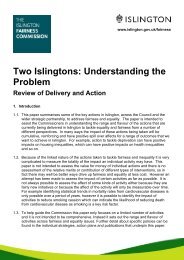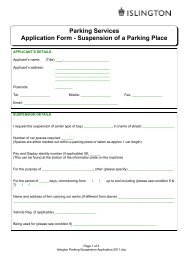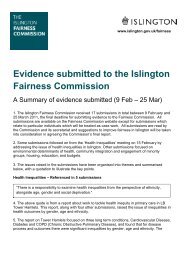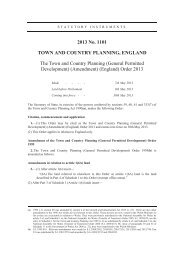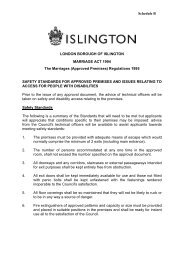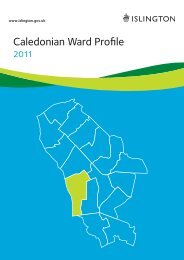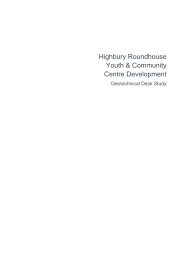Create successful ePaper yourself
Turn your PDF publications into a flip-book with our unique Google optimized e-Paper software.
From Munich to Highbury:<br />
<strong>Walter</strong> <strong>Sickert</strong> and the <strong>Sickert</strong><br />
family collection in <strong>Islington</strong><br />
<strong>Islington</strong> <strong>Council</strong>’s <strong>Walter</strong> <strong>Sickert</strong> family collection<br />
contains the paintings, drawings and etchings<br />
found in <strong>Sickert</strong>’s studio at the time of his death,<br />
along with an archive of his photographs and<br />
personal papers.<br />
Most of this material was deposited with <strong>Islington</strong><br />
Libraries by the <strong>Sickert</strong> Trust (1947-1950) in<br />
recognition of the significance of <strong>Islington</strong> in<br />
the artist’s life. The collection reflects <strong>Sickert</strong>’s<br />
enduring reputation as an artist, writer, teacher<br />
and eccentric.<br />
<strong>Sickert</strong>’s <strong>Islington</strong> works are featured in this<br />
exhibition, which also shows other trademark<br />
subjects, including figure studies, music halls and<br />
the streets and buildings of Dieppe and London.<br />
For the most part, these artworks are not finished<br />
works but they show how <strong>Sickert</strong> recorded his<br />
visual impressions in preparatory sketches that<br />
were the very source and foundation of his art.<br />
The collection also includes paintings by members<br />
of <strong>Sickert</strong>’s family and by his wife, Thérèse<br />
Lessore, and these too are displayed here.<br />
<strong>Walter</strong> <strong>Sickert</strong>’s palette.<br />
<strong>Walter</strong> <strong>Sickert</strong> in 1923.<br />
<strong>Walter</strong> <strong>Sickert</strong>. Cicely Hey. Etching.<br />
1922-1924 (circa). 20 x 17.5 cm.
<strong>Walter</strong> Richard <strong>Sickert</strong><br />
(1860–1942)<br />
The <strong>Sickert</strong> family<br />
<strong>Walter</strong> <strong>Sickert</strong> was born in Munich on 31 May 1860. His father was<br />
Oswald <strong>Sickert</strong>, a Danish artist. His mother, Eleanor Henry, was the<br />
illegitimate daughter of an Irish dancer and an Englishman, Richard<br />
Sheepshanks, the Astronomer Royal.<br />
Oswald and Eleanor <strong>Sickert</strong> married in 1859 and <strong>Walter</strong> <strong>Sickert</strong> was<br />
the first of their six children. The family moved to England in 1868.<br />
From acting to art<br />
<strong>Sickert</strong> initially pursued a career in acting and played several minor<br />
roles between 1879 and 1881. He gave up acting to join the Slade<br />
School of Fine Art in October 1881 but left after a few months to<br />
become an apprentice to the artist James McNeill Whistler.<br />
As a late Victorian painter, <strong>Sickert</strong> first became known as an English<br />
Impressionist. However, his long career spanned many phases in<br />
British art and he is acknowledged as a major influence on the work of<br />
twentieth century artists.<br />
<strong>Walter</strong> <strong>Sickert</strong> outside his<br />
Camden Road studio, c1933.<br />
<strong>Walter</strong> <strong>Sickert</strong> and Thérèse Lessore, 1930s.<br />
<strong>Sickert</strong> at the Bath School of Art, probably<br />
photographed during his final lectures in 1939.<br />
Letter from <strong>Walter</strong> <strong>Sickert</strong><br />
to his mother, c1870. His<br />
writing is difficult to decipher<br />
- his mother said that he<br />
wrote “such affectionate<br />
letters in such vile German”.<br />
Travel and marriage<br />
<strong>Walter</strong> <strong>Sickert</strong> in Dieppe,<br />
August 1920.<br />
<strong>Sickert</strong> travelled and moved frequently during<br />
his life. He spent time working amongst fellow<br />
artists in Dieppe and the English community<br />
in Venice. He also took various residences in<br />
England, especially London, and lived and worked<br />
in <strong>Islington</strong> during the 1920s and 1930s.<br />
He married three times, firstly in 1885 to Ellen<br />
Cobden, daughter of the radical MP Richard<br />
Cobden. They divorced in 1899. His second<br />
marriage, to Christine Angus, an art pupil, lasted<br />
from 1911 until her death in 1920. He married his<br />
third wife, the painter Thérèse Lessore, in 1926.<br />
<strong>Sickert</strong> and Lessore lived in Bathampton, near Bath,<br />
at the time of his death on 22 January 1942.<br />
A sinister reputation<br />
In recent years, <strong>Sickert</strong> has become notorious as a<br />
suspect for the ‘Jack the Ripper’ murders. These<br />
claims, however, have been widely discredited.
The work of <strong>Walter</strong> <strong>Sickert</strong><br />
Early influences<br />
As Whistler’s apprentice, <strong>Sickert</strong> learned to paint from life but he<br />
was soon influenced by the work of Edgar Degas, who painted<br />
in the studio from rough sketches. <strong>Sickert</strong> learned from him the<br />
technique of using a grid to enlarge an image onto canvas.<br />
He was also inspired by the dark, urban themes of Degas’ work<br />
and began to paint scenes of bawdy music halls. As an early<br />
member of the New English Art Club – founded in 1886 to<br />
challenge the conservative Royal Academy of Arts – <strong>Sickert</strong><br />
gained a reputation as one of the ‘London impressionists’.<br />
Illustration squared up by <strong>Sickert</strong> to<br />
be enlarged as a sketch or painting.<br />
<strong>Sickert</strong> in academic robes, to accept<br />
an honorary doctorate from Reading<br />
University, March 1938.<br />
<strong>Walter</strong> <strong>Sickert</strong>. Sally. Etching.<br />
1915 (circa). 17 x 11 cm.<br />
Caricature by <strong>Sickert</strong> of<br />
his friend, the writer Israel<br />
Zangwill (published in Vanity<br />
Fair, 25 February 1897).<br />
Themes<br />
Leaflet (c1913) advertising an<br />
art school run by <strong>Walter</strong> <strong>Sickert</strong><br />
near Camden Town.<br />
From the 1890s, <strong>Sickert</strong> worked mainly abroad<br />
and painted circuses and music halls, portraits and<br />
caricatures, landscapes, buildings and street scenes.<br />
However, during his Camden Town period (1905-<br />
1914), he rented dingy studios in north London,<br />
where he produced many of the interior figure<br />
drawings for which he is most recognised. His work<br />
influenced younger artists, with whom he established<br />
the Camden Town Group in 1911. This later became<br />
the London Group, which survives today.<br />
From the 1920s, <strong>Sickert</strong> used photographs and<br />
illustrations as the basis for his work, still using the<br />
‘squaring up’ technique. He became known for<br />
producing full-scale portraits of royalty and other<br />
personalities from published photographs.<br />
Author and teacher<br />
<strong>Sickert</strong>’s articles and letters appeared in major<br />
publications such as The New York Herald, The<br />
Daily Telegraph and The Burlington Magazine. He<br />
taught widely, lecturing at established schools of art<br />
and elsewhere, as well as setting up private studios in<br />
London to teach painting, drawing and etching.
<strong>Sickert</strong>’s early years<br />
in <strong>Islington</strong><br />
<strong>Islington</strong> was a major presence at either end of <strong>Sickert</strong>’s life,<br />
personally and professionally. The artist appeared to be genuinely<br />
fond of the district and remarked in 1932, “<strong>Islington</strong> has always<br />
been kind to me.”<br />
St Mark’s Hospital and Duncan Terrace (1865)<br />
It was under unfortunate personal circumstances that a five-year-old <strong>Walter</strong><br />
<strong>Sickert</strong> first visited <strong>Islington</strong>. In 1865, he attended St Mark’s, City Road, a<br />
specialist fistula hospital, to undergo a life-saving operation. Afterwards, he<br />
stayed with his maternal great-aunt, Anne Sheepshanks, who had rented<br />
rooms in nearby Duncan Terrace.<br />
Sadler’s Wells Theatre, c1900, where twenty years<br />
earlier <strong>Sickert</strong> trod the boards as an actor.<br />
Collins’ Music Hall, 1906; a favourite haunt of <strong>Sickert</strong>’s for five decades.<br />
Impersonating Demetrius with<br />
“fair effect”: <strong>Sickert</strong> (Sigurd)<br />
at Sadler’s Wells. (Theatre<br />
magazine, July 1880).<br />
St Mark’s Hospital, City Road. (Illustrated<br />
London News, 14 August 1852).<br />
Claremont Square<br />
(1880-1881)<br />
German-born <strong>Walter</strong> and his family<br />
emigrated to England in 1868, settling<br />
initially in Bedford. It was however<br />
not until around 1880 that he was to<br />
return to the <strong>Islington</strong> area. Now an<br />
actor, <strong>Sickert</strong> was assigned lodgings<br />
for a short time at Claremont Square,<br />
off Pentonville Road. He worked, on<br />
occasion, as a utility player at nearby<br />
Sadler’s Wells Theatre. In June and<br />
July that year, and billed as ‘Mr Sigurd’,<br />
<strong>Sickert</strong> played the role of Demetrius in<br />
Shakespeare’s A Midsummer Night’s<br />
Dream. In 1881 he abandoned ‘the<br />
boards’, deciding instead to pursue a<br />
career as an artist.<br />
Collins’ Music Hall<br />
After leaving Claremont Square, <strong>Sickert</strong><br />
returned to <strong>Islington</strong> as a frequent<br />
visitor to Collins’ Music Hall, <strong>Islington</strong><br />
Green. He was often seen at the theatre<br />
‘studying’ the artistes, audience and<br />
atmosphere for future works.
An <strong>Islington</strong> resident<br />
<strong>Sickert</strong> continued to be inspired by <strong>Islington</strong> and, between<br />
1924 and 1934, he lived and worked at several addresses<br />
in the borough.<br />
Noel Street (1924-1931)<br />
He rented a studio at 26 Noel Street (later 54 Noel Road)<br />
and began to paint and etch the neighbourhood, often from<br />
photographs. <strong>Islington</strong> locations featured in his work, from<br />
Collins’ Music Hall to the Royal Agricultural Hall and from views of<br />
Canonbury Tower to the back gardens of Noel Street.<br />
Quadrant Road (1927-1931)<br />
<strong>Sickert</strong> and his third wife, Thérèse Lessore, bought Southey<br />
Villa, 15 Quadrant Road. Here, his well-known eccentricity was<br />
demonstrated by replacing the conventional lavatories with<br />
French-style floor pans –he apparently wished to witness his<br />
visitors’ reactions as they emerged!<br />
1 Highbury Place, 2010, where a<br />
plaque commemorates <strong>Sickert</strong>’s<br />
school of art. Thérèse Lessore also<br />
had a studio here.<br />
<strong>Sickert</strong> in chef’s hat at Highbury<br />
Place, c1930. When first teaching,<br />
<strong>Sickert</strong> was known to wear a different<br />
hat each day!<br />
12 Barnsbury Park, 2010. Once<br />
number 14, this was the <strong>Sickert</strong>s’<br />
final residence in <strong>Islington</strong>.<br />
54 Noel Road, 2010.<br />
Highbury Place (1927-1934)<br />
<strong>Sickert</strong> opened the last of his ateliers at 1 Highbury<br />
Place, which also served as a school of painting. No<br />
models were employed and pupils were restricted to<br />
men only.<br />
Here, <strong>Sickert</strong> painted The raising of Lazarus, an<br />
initial full-size sketch having been drawn on the<br />
studio’s papered wall. In 1932, he gave the finished<br />
painting to be sold for the benefit of Sadler’s Wells<br />
Company. <strong>Sickert</strong> said that it was “given in memory<br />
of my perpetual admiration of Sam Phelps and my<br />
gratitude to Isabel Bateman of whose Sadler’s Wells<br />
Company I was myself a utility member.”<br />
Barnsbury Park (1931-1934)<br />
The <strong>Sickert</strong>s moved from Quadrant Road to 14<br />
(now number 12) Barnsbury Park. <strong>Sickert</strong> found<br />
nearby Pentonville Prison a useful landmark for<br />
directing taxi drivers. He left <strong>Islington</strong> for St Peter’s-<br />
in-Thanet, Broadstairs, Kent.<br />
The back gardens of Noel<br />
Road, shown here in 1967;<br />
the inspiration for <strong>Sickert</strong>’s<br />
Hanging gardens of <strong>Islington</strong>.
<strong>Sickert</strong> abroad<br />
Paris, France<br />
In April 1883, carrying letters of introduction to Edgar<br />
Degas and Édouard Manet, <strong>Sickert</strong> took Whistler’s painting,<br />
Portrait of the Artist’s Mother, to Paris for exhibition.<br />
Although Manet was too ill to see him, Degas invited the<br />
young artist to visit his studio. The two later consolidated<br />
their friendship in Dieppe.<br />
While living in Dieppe in the early 1900s, <strong>Sickert</strong> made<br />
frequent visits to the French capital, teaching with his friend<br />
Jacques-Émile Blanche and working. <strong>Sickert</strong> especially<br />
enjoyed painting and etching Parisian music halls, including<br />
La Gaieté Rochechouart.<br />
Dieppe, France<br />
From 1885 until 1922, the northern French harbour<br />
town of Dieppe became a second home to <strong>Walter</strong> <strong>Sickert</strong>.<br />
Attracted to the town’s artistic scene, he came here with his<br />
first wife just after their marriage in 1885.<br />
<strong>Sickert</strong> went to Dieppe in 1898 and did not return to<br />
London until 1905. He continued to visit the French town<br />
and, from 1911, stayed in the nearby village of Envermeu.<br />
In 1919, following confinement in England during the<br />
First World War, <strong>Sickert</strong> again spent much of his time in<br />
Envermeu. After the death of his second wife a year later,<br />
the artist moved to Dieppe until his return to London in<br />
1922.<br />
Venice, Italy<br />
<strong>Sickert</strong> visited Venice several times from 1895 to 1904.<br />
On all but the last visit, he produced landscapes and<br />
occasional portraits. However, during the winter of 1903-<br />
1904, he escaped the city’s bad weather by painting and<br />
etching intimate interior figure subjects, developing the<br />
themes for which he later became famous.<br />
<strong>Walter</strong> <strong>Sickert</strong>. Venetian<br />
woman seated at corner of<br />
sofa. Pen and charcoal on<br />
toned paper. 1903.<br />
31 x 22 cm.<br />
One of many drawings and<br />
paintings showing the young<br />
Venetian prostitutes who<br />
posed for <strong>Sickert</strong>.<br />
<strong>Walter</strong> <strong>Sickert</strong>. La Gaieté Rochechouart. Etching. 1906. 10 x 14.5 cm.<br />
<strong>Sickert</strong> produced four oil paintings and numerous drawings of this<br />
music hall during an autumn visit to Paris in 1906.<br />
Edgar Degas in Dieppe<br />
in 1885.<br />
<strong>Walter</strong> <strong>Sickert</strong>. St Jacques,<br />
Dieppe. The façade. Pen and<br />
pencil on toned paper. 1914<br />
(circa). 19 x 16 cm.<br />
Edgar Degas. Six amis. Pastel.<br />
1885. 37 x 24 cm (Reproduction).<br />
Original: Museum of Art, Rhode<br />
Island School of Design.<br />
Degas drew his ‘six friends’ –<br />
<strong>Walter</strong> <strong>Sickert</strong>, Jacques-Émile<br />
Blanche, Ludovic and Daniel Halévy,<br />
Henri Gervex and Albert Cavé – in<br />
Blanche’s studio in Dieppe.<br />
<strong>Sickert</strong> with Christine Angus, his second wife, who died in<br />
France in 1920.
The <strong>Sickert</strong> family<br />
<strong>Walter</strong> <strong>Sickert</strong> came from an artistic background and<br />
<strong>Islington</strong>’s <strong>Sickert</strong> collection includes works by several<br />
members of his family.<br />
Johann Jürgen <strong>Sickert</strong> (1803-1864)<br />
<strong>Walter</strong> <strong>Sickert</strong>’s paternal grandfather was the head of a firm of<br />
decorators employed in royal palaces by King Christian VIII of<br />
Denmark, as well as an accomplished artist.<br />
Oswald <strong>Sickert</strong>. Self-portrait. Oil.<br />
1844 (circa). 44.5 x 36 cm.<br />
Bernhard <strong>Sickert</strong>. Distant Dinan.<br />
Oil on panel. No date. 24 x 35.5 cm.<br />
Oswald <strong>Sickert</strong>. Portrait of<br />
Nellie <strong>Sickert</strong>. Oil. No date.<br />
34.5 x 25.5 cm.<br />
Eleanor <strong>Sickert</strong> (1830-1922),<br />
known as Nellie.<br />
Johann Jürgen <strong>Sickert</strong>. The road to the north. Oil. No date.<br />
27 x 40 cm.<br />
Oswald Adalbert <strong>Sickert</strong><br />
(1828-1885)<br />
<strong>Walter</strong> <strong>Sickert</strong>’s father was born in Altona, Germany,<br />
and did much of his artistic training in Paris.<br />
During the 1890s, Oswald worked in Munich as<br />
an illustrator for Fliegende Blätter, a humorous<br />
magazine. He fostered his son’s appreciation for<br />
the work and techniques of German and English<br />
popular illustrators and <strong>Walter</strong> <strong>Sickert</strong> acknowledged<br />
that his father’s tuition helped prepare him for the<br />
understanding of Whistler’s painting.<br />
After moving to England with his family, Oswald<br />
frequently exhibited work in London at the Dudley<br />
Gallery and occasionally at the Royal Academy.<br />
Bernhard [Bernard] <strong>Sickert</strong> (1863-1932)<br />
<strong>Walter</strong> <strong>Sickert</strong>’s brother was known as a landscape artist and he worked in oil and<br />
pastel. He too was a member of the New English Art Club and exhibited his work<br />
during the 1880s and 1890s.<br />
He was, however, an alcoholic and his obituary in The Times (8 August 1932) said<br />
that he “had talent and taste, but [appeared] to have lacked the perseverance to<br />
make the best use of his powers”.
Thérèse Lessore and<br />
Jules Lessore<br />
Thérèse Lessore (1884-1945)<br />
“A rare talent happily employed”<br />
Thérèse Lessore was a talented painter of landscapes, interiors and<br />
circus scenes. In both inspiration and technique, her work shows<br />
much in common with that of <strong>Walter</strong> <strong>Sickert</strong>. Thérèse also came<br />
from an artistic family of continental painters.<br />
Beginnings<br />
Born in Southwick, Sussex, in 1884, she studied at the Slade School<br />
of Art, London, where <strong>Sickert</strong> had also attended. She married<br />
fellow artist and leading member of the Bloomsbury Group, Bernard<br />
Adeney, in 1909 and they divorced in 1921.<br />
<strong>Walter</strong> <strong>Sickert</strong><br />
Thérèse became a close friend of <strong>Sickert</strong> and studied at the<br />
Rowlandson House School, Camden Town, which he founded in<br />
1910. She was elected to the London Group four years later at a<br />
meeting over which <strong>Sickert</strong> presided.<br />
<strong>Sickert</strong>’s artistic influence on Thérèse was considerable and he also<br />
admired her work. Together, they indulged their love of circuses,<br />
theatre and music hall, both as entertainment and as subjects for<br />
painting.<br />
Marriage<br />
Thérèse married <strong>Sickert</strong> in Margate in June 1926 and the marriage<br />
survived until his death in 1942. She died three years later and is<br />
buried with <strong>Sickert</strong> in the churchyard of St Nicholas, Bathampton.<br />
Jules Lessore. Self-portrait. Oil on<br />
board. No date. 32 x 34 cm.<br />
Thérèse Lessore and <strong>Walter</strong><br />
<strong>Sickert</strong> during the 1920s.<br />
Programme for the Royal<br />
Agricultural Hall World’s Fair<br />
Circus, 1929-1930. The<br />
circus provided inspiration<br />
for the <strong>Sickert</strong>s’ work.<br />
“A rare talent happily<br />
employed” concludes<br />
this sympathetic review<br />
of Thérèse Lessore’s<br />
work. (The Times, 20<br />
April 1931).<br />
Thérèse Lessore. Swallow’s<br />
Circus, Royal Agricultural Hall.<br />
Oil on canvas. 1930 (circa).<br />
30 x 20.5 cm.<br />
Jules Frederick Lessore (1849-1892)<br />
Jules Lessore, a Paris-born painter and etcher, was the father of Thérèse<br />
Lessore. His own father, Emile-Aubert Lessore (1805-1876), was a<br />
famous decorator for Wedgwood Potteries.<br />
Jules Lessore settled in England in 1871, with his wife Ada Louisa Cooper.<br />
He died in Rotherfield, Sussex, and is buried in Woking Cemetery.


